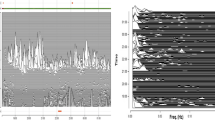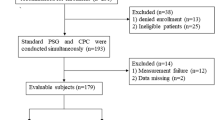Abstract
Study objective
The goal was to determine the utility and accuracy of automated analysis of single-lead electrocardiogram (ECG) data using two algorithms, cardiopulmonary coupling (CPC), and cyclic variation of heart rate (CVHR) to identify sleep apnea (SA).
Methods
The CPC-CVHR algorithms were applied to identify SA by analyzing ECG from diagnostic polysomnography (PSG) from 47 subjects. The studies were rescored according to updated AASM scoring rules, both manually by a certified technologist and using an FDA-approved automated scoring software, Somnolyzer (Philips Inc., Monroeville, PA). The CPC+CVHR output of Sleep Quality Index (SQI), Sleep Apnea Indicator (SAI), elevated low frequency coupling broadband (eLFCBB) and elevated low frequency coupling narrow-band (eLFCNB) were compared to the manual and automated scoring of apnea hypopnea index (AHI).
Results
A high degree of agreement was noted between the CPC-CVHR against both the manually rescored AHI and the computerized scored AHI to identify patients with moderate and severe sleep apnea (AHI > 15). The combined CPC+CVHR algorithms, when compared to the manually scored PSG output presents sensitivity 89%, specificity 79%, agreement 85%, PPV (positive predictive value) 0.86 and NPV (negative predictive value) 0.83, and substantial Kappa 0.70. Comparing the output of the automated scoring software to the manual scoring demonstrated sensitivity 93%, specificity 79%, agreement 87%, PPV 0.87, NPV 0.88, and substantial Kappa 0.74.
Conclusion
The CPC+CVHR technology performed as accurately as the automated scoring software to identify patients with moderate to severe SA, demonstrating a clinically powerful tool that can be implemented in various clinical settings to identify patients at risk for SA.
Trial registration
NCT01234077.

Similar content being viewed by others
References
Frost & Sullivan (2016) Hidden health crisis costing America billions. American Academy of Sleep Medicine. (http://www.aasmnet.org/Resources/pdf/sleep-apnea-economic-crisis.pdf). Assessed 30 March 2017
Peppard PE, Young TE, Barnet JH, Palta M, Hagen EW, Hla KM (2013) Increased prevalence of sleep-disordered breathing in adults. Am J Epidemiol 177:1006–1014. https://doi.org/10.1093/aje/kws342
Young T, Finn L, Peppard PE et al (2008) Sleep disordered breathing and mortality: eighteen-year follow-up of the Wisconsin sleep cohorts. Sleep 31:1071–1078
Khayat R, Pleister A (2016) Consequences of obstructive sleep apnea: cardiovascular risk of obstructive sleep aand whether continuous positive airway pressure reduces that risk. Sleep Med Clin 11:273–286. https://doi.org/10.1016/j.jsmc.2016.05.002
Beuters F, Reitzschel ER, Hertegonne KB, Chirinos JA (2016) The link between obstructive sleep apnea and cardiovascular disease. Curr Atheroscler Rep 18:1. https://doi.org/10.1007/s11883-015-0556-z
Zhao YY, Redline S (2015) Impact of continuous positive airway pressure on cardiovascular risk factors in high-risk patients. Curr Atheroscler Rep 17(11):62. https://doi.org/10.1007/s11883-015-0540-7
Conwell W, Tsai S (2016) Managing comorbid illness in obstructive sleep apnea. What can we learn from other diseases? Sleep Med Clin 11:313–321. https://doi.org/10.1016/j.jsmc.2016.04.007
Chung F, Abdullah H, Liao P (2016) STOP-Bang Questionnaire: a practical approach to screen for obstructive sleep apnea. Chest 149(3):613–618. https://doi.org/10.1378/chest.15-0903
Barrett PM, Komatireddy R, Haaser S et al (2014) Comparison of 24-hour Holter monitoring with 14-day novel adhesive patch electrocardiographic monitoring. Am J Med 127:95 211–95 217. https://doi.org/10.1016/j.amjmed.2013.10.003
Thomas RJ (2016) Cardiopulmonary coupling sleep spectrograms. In: Kryger MH, Roth T, Dement WC (eds) Principles and practice of sleep medicine, 6rd edn. Elsevier, Inc., Philadelphia, pp 1615–1623
Thomas RJ, Mietus JE, Peng CK, Guo D, Montgomery-Downs H, Gottlieb DJ, Wang CY, Goldberger AL (2014) Relationship between delta power and the electrocardiogram-derived cardiopulmonary spectrogram. Possible implications for assessing the effectiveness of sleep. Sleep Med 15(1):125–131. https://doi.org/10.1016/j.sleep.2013.10.002
Mietus JE, Peng CK, Ivanov PCh, Goldberger AL (2000) Detection of obstructive sleep apnea from cardiac interbeat interval time series. Comput Cardiol 27:753–6. https://doi.org/10.1109/CIC.2000.898634
Guilleminault C, Connolly S, Winkle R, Melvin K, Tilkian A (1984) Cyclical variation of the heart rate in sleep apnea syndrome: mechanisms, and usefulness of 24h electrocardiography as a screening technique. Lancet 1(8369):126–131
Centers for Medicare & Medicaid Services (2009) Decision memo for sleep testing for obstructive sleep apnea (OSA). Assessed 30 March 2017. https://www.cms.gov/medicare-coverage-database/details/nca-decision-memo.aspx?NCAId=227&ver=11&NcaName=Sleep+Testing+for+Obstructive+Sleep+Apnea+(OSA)&CoverageSelection=National&KeyWord=sleep+testing&KeyWordLookUp=Title&KeyWordSearchType=And&bc=gAAAACAAEAAA&
Whitney CW, Gottlieb DJ, Redline S et al (1998) Reliability of scoring respiratory disturbance indices and sleep staging. Sleep 21(7):749–757
Magalang UJ, Chen NH, Cistulli PA et al (2013) Agreement in the scoring of respiratory events and sleep among international sleep centers. Sleep 36(4):591–596. https://doi.org/10.5665/sleep.2552
Harrington J, Schramm PJ, Davies CR, Lee-Chiong TL (2013) An electrocardiogram-based analysis evaluating sleep quality in patients with obstructive sleep apnea. Sleep Breath 17(3):1071–1078. https://doi.org/10.1007/s11325-013-0804-9
Julious SA (2005) Sample size of 12 per group rule of thumb for a pilot study. Pharm Stats 4(4):287–291
Iber C, Ancoli-Israel S, Chesson AL Jr et al (2007) The AASM manual for the scoring of sleep and associated events: rules, terminology and technical specifications, 1st edn. American Academy of Sleep Medicine, Westchester
Punjabi N, Shifa N, Dorffner G, Patil S, Pien G, Aurora RN (2015) Computer-assisted automated scoring of polysomnograms using the Somnolyzer system. Sleep 38(10):1555–1566. https://doi.org/10.5665/sleep.5046
Thomas RJ, Mietus JE, Peng CK, Gilmarin G, Daly RW, Goldberger AL, Gottlie DJ (2007) Differentiation obstructive from central and complex sleep apnea using an automated electrocardiogram-based method. Sleep 30(12):1756–1759
Lee WH, Ahn JC, We J, Rhee CS, Lee CH, Yun PY, Yoon IY, Kim JW Cardiopulmonary coupling analysis: changes before and after treatment with mandibular advancement device. Sleep Breath 18(4):891–896. https://doi.org/10.1007/s11325-014-0961-5
Choi JH, Thomas RJ, Suh SY et al (2015) Sleep quality changes after upper airway surgery in obstructive sleep apnea. Electrocardiogram-based cardiopulmonary coupling analysis. Laryngoscope 125(7):1737–1742. https://doi.org/10.1002/lary.25101
Lee WH, Hong SN, Kim HJ, Rhee CS, Lee CH, Yoon IY, Kim JW (2016) A Comparison of different success definitions in non-continuous positive airway pressure treatment for obstructive sleep apnea using cardiopulmonary coupling. J Clin Sleep Med 1:35–41. https://doi.org/10.5664/jcsm.5388
Lee SH, Choi JH, Park IH et al (2012) Measuring sleep quality after adenotonsillectomy in pediatric sleep apnea. Laryngoscope 122(0):2115–2121. https://doi.org/10.1002/lary.23356
Guo D, Peng CK, HL W, Mietus JE, Liu Y, Sun RS, Thomas RJ (2011) ECG-derived cardiopulmonary analysis of pediatric sleep-disorder breathing. Sleep Med 12:384–389. https://doi.org/10.1016/j.sleep.2010.09.011
Schramm PJ, Thomas R, Feige B, Spiegelhalder K, Riemann D (2013) Quantitative measurement of sleep quality using cardiopulmonary coupling analysis: a retrospective comparison of individuals with and without primary insomnia. Sleep Breath 17(2):713–721. https://doi.org/10.1007/s11325-012-0747-6
Schramm PJ, Zobel I, Monch K, Schramm E, Michalak J (2016) Sleep quality changes in chronically depressed patients treated with mindfulness-based cognitive therapy or the cognitive behavioral analysis system of Psycotherapy: a pilot study. Sleep Med 17:57–63. https://doi.org/10.1016/j.sleep.2015.09.022
StataCorp (2011) Stata statistical software: release 12. StataCorp LP, College Station
Hayano J, Watanabe E, Saito Y et al (2011) Screening for obstructive sleep apnea by cyclic variation of heart rate. Circ Arrythym Electrophysiol 4(1):64–72. https://doi.org/10.1161/CIRCEP.110.958009
Corthout J, Van Huffel S, Mendez MO, Bianchi AM, Penzel T, Cerutti S (2008) Automatic screening of obstructive sleep apnea from ECG based on empirical mode decomposition and wavelet analysis. Conf Proc IEEE Eng Med Biol Soc 2008:3608–3611. https://doi.org/10.1109/IEMBS.2008.4649987
Kandocker AN, Palaniswami M, Karmakar CK (2009) Support vector machines for automated recognition of obstructive sleep apnea syndrome from ECG recordings. Comput Biol Med 39(1):88–96. https://doi.org/10.1016/j.compbiomed.2008.11.003
Roche F, Celle S, Pichot V, Barthelemy JC, Sforza E (2007) Analysis of the interbeat interval increment to detect obstructive sleep apnoea/hypopnea. Eur Respir J 29(6):1206–1211. https://doi.org/10.1183/09031936.00042606
Quadri S, Drake C, Hudgel DV (2009) Improvement of idiopathic central sleep apnea with zolpidem. J Clin Sleep Med 5:122–129
Hanly PJ, Millar TW, Steljes DG, Baert R, Frais MA, Kryger MH (1989) Respiration and abnormal sleep in patients with congestive heart failure. Chest 96:480–488
Walker JM, Farney RJ, Rhondeau SM et al (2007) Chronic opioid use is a risk factor for the development of central sleep apnea and ataxic breathing. J Clin Sleep Med: JFCS: Off Publ Am Acad Sleep Med 3:455–461
Thomas RJ, Tamisier R, Boucher J et al (2013) Nocturnal hypoxia exposure with simulated altitude for 14 days does not significantly alter working memory or vigilance in humans. Sleep 30:1195–1203
Eiseman NA, Westover MB, Mietus JE, Thomas RJ, Bianchi MR (2012) Classification algorithms for predicting sleepiness and sleep apnea severity. J Sleep Res 21:101–112. https://doi.org/10.1111/j.1365-2869.2011.00935.x
Alshaer H, Bradley TD (2016) Positional sleep apnea is a cause of inter-night variability in the apnea hypopnea index. Am J Respir Crit Care Med 193: Meeting Abstracts:A2537
Krakow B, Ulibarri V, Romero E, Mclever ND (2013) A Two-year prospective study on the frequency of co-occurrence of insomnia and sleep-disordered breathing symptoms in primary care population. Sleep Med 14(9):814. https://doi.org/10.1016/j.sleep.2013.02.015
Bianchi MT, Williams KL, McKinney S, Ellenbogen JM (2013) The subjective-objective mismatch in sleep perception among those with insomnia and sleep apnea. J Sleep Res 22(5):557–558. https://doi.org/10.1111/jsr.12046
Castillo J, Goparaju B, Bianchi MT (2014) Sleep-wake misperception in sleep apnea patients undergoing diagnostic versus titration polysomnography. J Psycosom Res 76(5):361–367. https://doi.org/10.1016/j.jpsychores.2014.03.001
Kapur VK, Auckley DH, Chowdhuri S (2017) Clinical practice guideline for diagnostic testing for adult obstructive sleep apnea: an American Academy of Sleep Medicine Clinical Practice Guide. J Clin Sleep Med 13(3):479–504. https://doi.org/10.5664/jcsm.6506
Acknowledgements
The authors wish to thank Dr.Teofilo L. Lee-Chiong Jr., for facilitating and supervising the data collection at the Sleep Medicine Laboratory, National Jewish Health Hospital, Denver, CO and for reviewing this manuscript. We also thank Dr. John Harrington, who collected the data, clinically diagnosed patients, and reviewed all PSG studies and original scoring, and Mr. Troy Pridgeon, RPSGT for rescoring the PSG studies according to the updated AASM scoring guidelines 2017.
Funding
No funding was received for this research.
Author information
Authors and Affiliations
Contributions
Solveig Magnusdottir: Initial drafting, final approval of the manuscript, guarantor of the overall content.
Hugi Hilmisson: Data analysis and final approval of the manuscript.
Corresponding author
Ethics declarations
The study protocol was approved by the Institutional Review Board of National Jewish Health, Denver, CO, USA. All procedures performed in studies involving human participants were in accordance with the ethical standards of the institutional committee and with the 1964 Helsinki Declaration and its later amendments or comparable ethical standards.
Conflict of interest
Magnusdottir Solveig, MD. MBA: Works as an medical director of MyCardio LLC.
Has a partial ownership. SleepImage is the brand name of MyCardio LLC, a privately held entity. MyCardio LLC is a licensee of the CPC+CVHR algorithms, a method to use ECG to phenotype sleep and sleep apnea, from the Beth Israel Deaconess Medical Center, Boston, MA, USA.
Hilmisson Hugi, MA: Works as a Data Analyst for MyCardio LLC.
SleepImage is the brand name of MyCardio LLC, a privately held entity. MyCardio LLC is a licensee of the CPC+CVHR algorithms, a method to use ECG to phenotype sleep and sleep apnea, from the Beth Israel Deaconess Medical Center, Boston, MA, USA.
Informed consent
Informed consent was obtained from all individual participants included in the study.
Clinical trial registration number
NCT01234077 - https://clinicaltrials.gov/show/NCT01234077
Clinical trial registry name
Comparing In-laboratory Polysomnography Electrocardiogram (PSG, ECG) to Simultaneously Recorded In-laboratory ECG on the CPC M1 Device.
Rights and permissions
About this article
Cite this article
Magnusdottir, S., Hilmisson, H. Ambulatory screening tool for sleep apnea: analyzing a single-lead electrocardiogram signal (ECG). Sleep Breath 22, 421–429 (2018). https://doi.org/10.1007/s11325-017-1566-6
Received:
Revised:
Accepted:
Published:
Issue Date:
DOI: https://doi.org/10.1007/s11325-017-1566-6




